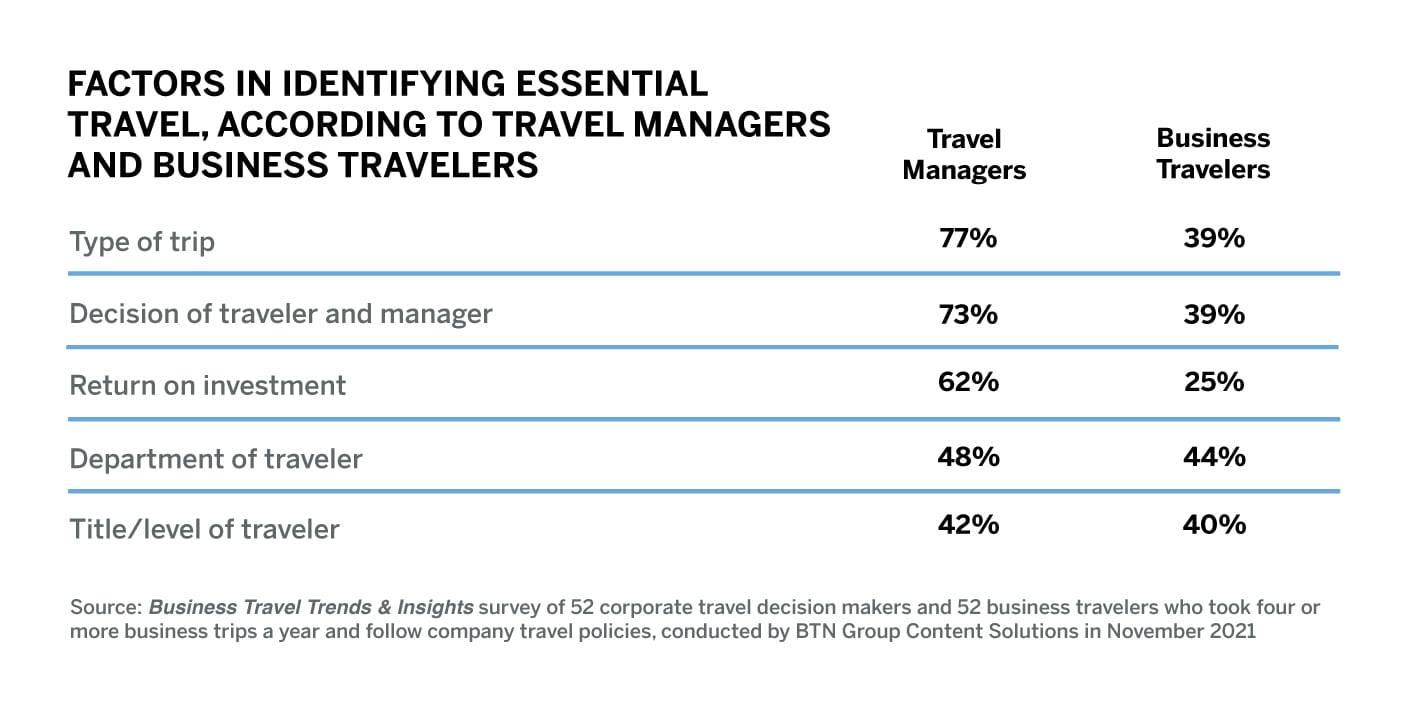Defining which types of business trips are appropriate during a pandemic is complicated, conditional and, at times, controversial. But understanding who in the organization should be allowed to travel can be even more puzzling. To the traveler, every trip is important, but to the organization, some travel can easily be replaced via virtual conferencing. It’s a tough call to decide which trips are more essential than the others, especially when considering budget and safety concerns. Consider this:
- Essential travel is mostly defined by type and purpose of a trip, although the role of the person traveling is also a factor
- Corporations are most likely to approve travel that can provide revenue in the short-term, such as a sales meeting
- Corporations prioritize travel related to customer care, while they expect many employee or internal meetings can be done remotely
With most corporations cutting back on travel altogether, corporations are putting trips in “buckets” based on importance, or rather, what is deemed crucial to gain a competitive edge. More than three-quarters of travel managers said they identify essential travelers by the type of trip they are taking and six in 10 consider return on investment (ROI) for each trip, according to Business Travel Trends & Insights survey conducted by BTN Group Content Solutions in November 2021. Status within the organization also matters. About half (48%) said department of employee is a factor, and four in 10 said title/level of employee is also important criteria (although the same percentage also said it wasn’t). But it’s not necessarily travel managers making the call, as seven in 10 state it’s up to each individual traveler and their manager to decide if a trip is necessary.

Business travelers can get frustrated if their reasons for a trip don’t make the cut. Most employees working remotely miss connections with colleagues, clients and prospects and want to get back on the road. According to the Business Travel Trends & Insights survey, more than six in 10 find it important to meet in person with co-workers and industry colleagues on a regular basis. Many, however, recognize the decision is out of their hands. While there is no clear consensus, more than four in 10 business travelers said the employee’s department is a top consideration when identifying essential travelers. Four out of 10 also said that title/level of the employee is a key factor. Nearly the same percentage said each individual traveler and their manager decide if a trip is necessary and that type of trip also mattered (e.g., sales, internal meeting, or conference). Interestingly, and out of sync with travel managers, only one quarter of business travelers said that ROI was a main criterion for identifying necessary travelers.
The survey results made clear that executives have their travel approved almost all the time, followed by salespeople. Employees looking to attend internal meetings or meet with colleagues are less likely to be considered essential travelers.
Naturally, the type of travel deemed necessary for one company may not apply to another. Also, criteria for trip approvals go well beyond trip purpose to include employee health/willingness to travel, safety precautions and border restrictions. Looking at Festive Road’s Permissible Travel Framework, three factors must be taken into consideration before hitting the road: company readiness, employee readiness, and government permission. Also, for some travelers, their jobs depend on physical contact. In a recent McKinsey and Company article, the employee segment that “never left” despite lockdowns, comprised about 15% of all corporate expenses in 2019. These include managers in manufacturing companies with a wide distribution of factories and plants and field operation workers.
As we look ahead into 2022, business travelers might find it even harder to judge the merits of a business trip, especially if corporations remain firm on policy. According to GBTA’s latest poll, 36% of corporate buyers have either introduced or are considering introducing new restrictions on non-essential business travel or new requirements related to business travel as a whole. While it is likely more companies will expand their list of approved travel categories, stricter considerations for each trip will remain. Most companies plan to analyze travel trends and spending patterns to understand and reinvent how and why employees travel, and half of travel managers in the Business Travel Trends & Insights survey plan to retrain travelers about the new realities of business travel. Considering these findings, this “new reality” will likely govern manager decisions and employee choice going forward.



